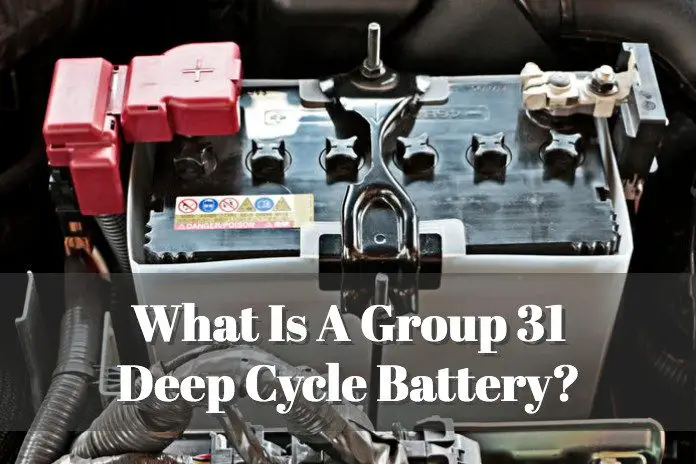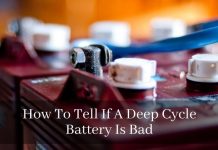
Different battery brands come with varying characteristics. Well, the versatility has enabled you, the user, to have a wide array of options to choose. At the same time, it has made it difficult for battery users to arrive at their battery of choice. This is where the Battery Council International (BCI) comes in the picture.
What does it mean when a cell is labeled as group deep cycle? A group 31 deep cycle battery is a battery model belonging to group 31 as per the Battery Council International (BCI). When we talk about a group 31 deep cycle battery, we mean that this battery is designed for deep discharge and charge cycle.
What Are Their Features and Applications?
These batteries are usually designed for off-grid and marine applications. The deep cycle batteries in group 31 typically have a capacity of about 20h. Their reserve capacity range from 240-250 and that’s with a 10 to 125 Ah.
Although the deep cycle batteries in this group are designed for deep discharge, they don’t deliver strong currents. However, they still feature incredible characteristics hence popular among many cars and boats. For example, some of the batteries in this category have a 20h capacity in the 120-125 Ah range.
If you’re looking to invest in a marine battery, specifically one in this group, you ought to understand every feature in detail. Group 31 is popular because of its BCI group size. Say, for instance, the most powerful batteries you can ever find in the market fall under the group 31 bracket.
Most of the batteries in this bracket have a capacity of 150-250 minutes. Such an ability combined with 750-1250 cold-cranking amps (CCA) makes the battery ideal for most basic functioning. The batteries are usually 13 x 6.8 x 44 inches (physical dimensions). The size makes the batteries explicitly perfectly suited for activities that require battery power to start.
Today, you will find batteries from group 31 being used in vehicles, marine, and various off the grid applications. As stated earlier, it’s this diversity that has made the group so popular. Therefore, if you’re out there hunting for your ideal battery, don’t be scared. You can find various battery models in group 31, both in the online stores and physical locations.
Why Are There Less Lithium Batteries in Group 31?
By analyzing the battery market, you will learn that flooded, gel, lead-acid, and AGM cells are the most common. The situation always leaves many curious buyers asking, why is it that there are no many lithium batteries in group 31.
First thing first, lithium batteries are a bit expensive as opposed to lead-acid batteries. Also, the fact that they hold a sensitive charging makes them less accessible in the market.
But, as opposed to the lead-acid batteries, the lithium batteries are light in weight. As a result, they are always recommended in a situation where weight saving is vital. The most conventional lithium batteries are the LiFePO4.
These kinds of cells are also referred to as batteries with a protective layer. The protective layer is what monitors the voltages, temperature, and charging/discharge current for the sake of the model’s sensitive charging.
Are There ‘Starting Batteries’ in the Group?
In group 31, we also have the starting battery, which is rare to find. However, from a manufacturer’s point of view, it’s easy to design. This specific battery is manufactured emphasizing characteristics and can be used more for dual purposes. When talking about group 31 cells, the best in the list has the power to deliver up to 1200 marine cranking amps (MCA) and 1000 cold-cranking amps (CCA).
The cold-cranking amps contribute to the max current once the cell is fully charged. At that state, the battery can deliver 12V for about half a minute without any fluctuations. The same model can as well operate within a range of 0 degrees or -18 degrees.
Marine charging amps, on the other end, contribute to the max current rate once the charging is complete. This kind of battery can easily be defined as one that can work at 32 degrees, delivering 1000 CCA.
Dual-Purpose Group 31 Cells
In addition to the starting batteries and deep cycle batteries, we also have dual-purpose models in group 31. These battery models are as well popular owing to their dominant features (robust current features). Dual-purpose batteries have perfect deep discharge performances.
An example of a cell is the dual-purpose category is the Green LiFe battery GL100, which provides 100Ah. Dual batteries give up to 900 cold-cranking amps up to 200 minutes RC. If you’re looking for a lighter battery in group 31, it’s recommended that you consider the dual purpose batteries.
What Are the Pros and Cons of Using Group 31 Deep Cycle Batteries?
Pros:
• All the batteries in group 31 have a low internal resistance
• Offers a long functional life with deep cycles
• It’s maintenance-free
• Offers electrical reliability
• Can survive under low temperatures without experiencing self-discharge
Cons:
• It delivers low current despite that the cells in group 31 have a small internal resistance
Conclusion
Knowing the various groups of batteries can be a bit challenging. This article covers the cells in group 31, which is more popular as compared to the other groups. By reading through the piece, you will learn everything you may need to know about the group and the battery categories featured.
The group 31 deep cycle batteries, especially, are common and a type that you should understand fully. By reading the article, you will learn more about the class and understand why it’s famous as opposed to the other models in the market.
Read through the entire piece to have a better understanding. By reading the article, you also will have a better knowledge of the battery model, which is the secret to a successful battery shopping experience.





